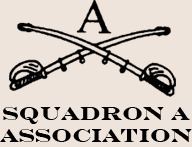Motto Boutez en avant! Legal status active | Formation 1889 | |
 | ||
Purpose to continue, preserve and forward the traditions, memory and contributions of Squadron A and the Horse Cavalry. Location Manhattan, New York United States | ||
Squadron A refers to the historic cavalry unit of New York City's Upper East Side.
Contents
Squadron A originated with a group of wealthy young gentlemen with great interest in equestrian sport who formed themselves into a group called the 'New York Hussars". They adopted fancy blue uniforms and headgear for ceremonial purposes that mimicked Eurasian fashions dating back to the Napoleonic and Crimean Wars. In effort to become more professional and militarized, they extended membership to Captain Charles F. Roe, twenty-year veteran of the US Army Cavalry, who inspired its membership with the cavalry spirit and military discipline. His efforts were successful to the point that in 1889 fifty-three men were mustered into the New York State National Guard as Troop A, becoming the cavalry arm of the Empire State. Squadron A was officially founded.
The Great Wars
Squadron A was often called out from its Madison Avenue Armory, which occupied an entire city block between 94th and 95th Streets, to escort presidents, governors, and foreign dignitaries. The Squadron was known for its fine riding skills and elegant uniforms, which it showed off in parades at the National Horse Show.
Members of Squadron served as soldiers as well. Volunteer Squadron A troopers served in the Puerto Rican Campaign in 1898, and in 1916 the entire Squadron was called into federal service to patrol the Mexican Border and to support the Pancho Villa Expedition. During World War I, 796 Squadron A members served, and 609 became commissioned officers. As part of the 105th Machine Gun Battalion, the Squadron played an important role in the smashing of the Hindenburg Line. Members were highly decorated, including a Medal of Honor recipient.
In World War II the unit was federalized as the 101st Cavalry, Horse/Mechanized in early 1941. Following Pearl Harbor, Squadron A men served in all branches of the armed forces worldwide, and two additional Medals of Honor were earned in addition to an array of other distinctions.
Social activities
In peacetime both between the Wars and directly following, the Squadron was the focus of active social life. Aside from official ceremonial duties, there was indoor polo in the Armory every Saturday night followed by a black tie-dance and many Sunday afternoon tea dances.
The 94th Street Armory came down in 1965, but its facade, with the Squadron motto BOUTEZ EN AVANT (Charge!) plaque is still intact, and the Hunter College High School building now occupying the rest of the block takes its architectural cues from the original Armory design.
Squadron A memorabilia is maintained in a museum at the Staten Island armory of the 101st Cavalry (Tank), NYARNG, the successor unit to the Squadron, at 321 Manor Road, Castleton Corners, Staten Island. The 101st was one of the first military units to respond to the terrorist attacks of September 11, 2001 aiding both citizens and police and have been mobilized in support of the Global War on Terror and Operation Iraqi Freedom.
The spirit and traditions of the Squadron A are maintained by the Squadron A Association, housed in the Women's National Republican Club building on 51st Street in Manhattan. Colonel Robert L. McClean, USAR (ret.) was president of the Association [He died on March 22, 2011, at his Manhattan residence after a lingering illness], which has more than 700 resident and non-resident members. The Squadron A Association maintains an active social agenda with an annual day at the Belmont Racetrack, an annual Memorial Service at the Church of the Heavenly Rest in Manhattan with reception, and a Christmas cocktail party. Additional events have included a Cavalry ball, visits aboard an aircraft carrier during Armed Forces Week, West Point football outings, and polo and shooting parties.
